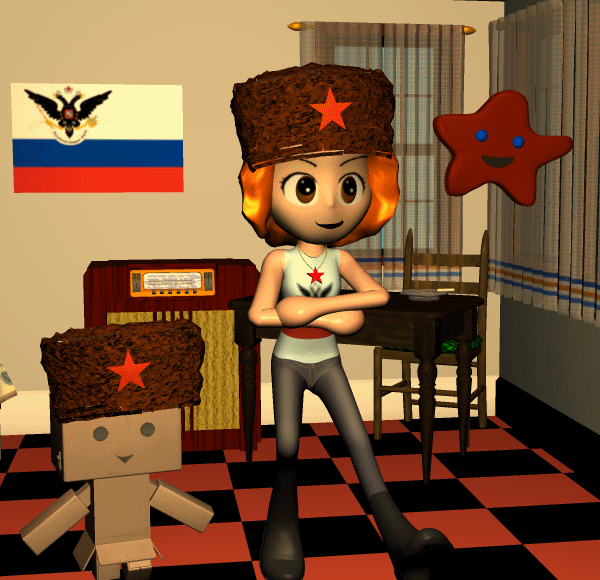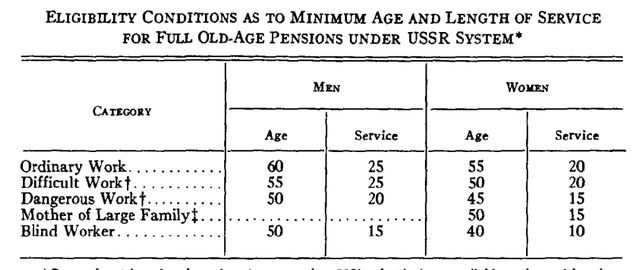Friday, June 15, 2018
More Soviet surprises
RT mentions
a new Russian law raising the age for Social Security. Here in wonderful USA STRONG we're
raising the age from 65 to 70. Russia is raising the age FROM 60 for men and 55 for women
TO 65 for men and TO 63 for women, gradually over the next 10 years.
Surprised me. Turns out that the 60m/55w age has been in place since 1930, longer than our
system with its 65 limit. Our original Townsend Plan was meant to start at 60, but by the time it was written up it was "compromised".
Found an excellent brief account of pensions and similar services. Better than
the 1968 Dept of Commerce document I've been using, which was a good source on banking and profits but not useful on these subjects.
This PDF is a brief 1959 article by Robert Myers in a trade journal for actuaries. Myers goes into heavy detail on stuff that actuaries find interesting, but also gives a clear and concise description of savings, insurance and medical care.
Myers felt the need to pre-defend his findings against our idiotic pre-conceptions about Communism, which haven't changed one fucking bit since 1959.
 Savings accounts:
Savings accounts:
 Overall this illustrates yet again the distinction between the Natural Law system of employment versus the Yankee system. The Natural Law system, which Yankees call "slavery", provides lifetime security in exchange for a restricted range of income. The Yankee system, which Yankees call "rights", makes no provision at all for security. If you are a New Yorker you get vast rewards. If not, you have the "right" to die and nobody will give a fuck.
= = = = =
Footnote: While I was looking up other sources to be sure Myers was right, I repeatedly noticed that the old structures are still there. The state insurance company Gosstrakh is still running, and the pension system and medical system haven't changed much. In other words, Russia has preserved the GOOD PARTS of the Soviet system while releasing total state control. In my previous discussion, I saw that the Soviet system was in fact capitalist and profit-based. The most successful parts of modern Russia, like Rosneft and Rosatom, are still mostly state-owned and capitalist and profit-based.
CONCLUSION: State-owned and state-planned profit-based capitalism WORKS BETTER than our current share value system. Central planning vs "free" planning is no longer a variable. Our corporations are centrally planned by a few oligarchs (Bezos, Zuckerberg, Buffett, Bloomberg) so we can't claim "the invisible hand". There are only a few perfectly visible and perfectly bloody hands.
It shouldn't be surprising that central planning by government to serve the nation works better than central planning to serve a few psychotic alien lunatic monstrous genocidal demons.
Overall this illustrates yet again the distinction between the Natural Law system of employment versus the Yankee system. The Natural Law system, which Yankees call "slavery", provides lifetime security in exchange for a restricted range of income. The Yankee system, which Yankees call "rights", makes no provision at all for security. If you are a New Yorker you get vast rewards. If not, you have the "right" to die and nobody will give a fuck.
= = = = =
Footnote: While I was looking up other sources to be sure Myers was right, I repeatedly noticed that the old structures are still there. The state insurance company Gosstrakh is still running, and the pension system and medical system haven't changed much. In other words, Russia has preserved the GOOD PARTS of the Soviet system while releasing total state control. In my previous discussion, I saw that the Soviet system was in fact capitalist and profit-based. The most successful parts of modern Russia, like Rosneft and Rosatom, are still mostly state-owned and capitalist and profit-based.
CONCLUSION: State-owned and state-planned profit-based capitalism WORKS BETTER than our current share value system. Central planning vs "free" planning is no longer a variable. Our corporations are centrally planned by a few oligarchs (Bezos, Zuckerberg, Buffett, Bloomberg) so we can't claim "the invisible hand". There are only a few perfectly visible and perfectly bloody hands.
It shouldn't be surprising that central planning by government to serve the nation works better than central planning to serve a few psychotic alien lunatic monstrous genocidal demons.
Most people in the United States and Canada do not realize that the Soviet Union has an effective social security system. Undoubtedly, this position is subconsciously based on the feeling that the small concern shown by the Soviet government for the rights of individuals extends to aged and disabled persons, who can no longer be productive. This would also seem to be in accordance with the Communist principle, "He who does not work, neither shall he eat." Actually, the USSR has a very broad social security system that bears many resemblances to such programs in other countries. The Soviet Constitution provides for social insurance protection. Individuals on this side of the Iron Curtain, after learning of the existence of the Soviet social security system, might well expect the benefits to be flat amounts in accordance with the Communist principle, "From each according to his ability; to each according to his need." However, benefits under the Soviet system vary with earnings. Still another misconception that might arise is that the entire economic security of the Soviet citizen is provided by governmental programs. Although this is true to a very considerable extent, rather surprisingly it is by no means completely the case.
 Savings accounts:
Savings accounts:
The Soviet Union has more than 50,000 savings banks. About 43 million people have accounts of an average size of 1,850 rubles. (about 185 dollars at that time, which means about $1600 in today's dollars!) Interest is paid at the rate of 2% for short-term deposits and 3% for deposits of 1 year or more. Since there are no personal checking accounts in the Soviet Union, it would seem that most of the savings in these institutions are for short-term purposes.Life and accident insurance:
A single government-owned insurance company operates in most ways like insurance companies in other countries. This company sells not only life and accident insurance, but also casualty and fire insurance. Policies are sold and serviced by an agency force of about 40,000. Each agent has an exclusive geographic territory and is remunerated by commissions that vary from 6% to 20% depending on the type of insurance. The earnings of the agents appear to be relatively good, since they are about 50% higher than the average wage in industry and commerce. It appears that about 10 million persons are insured for life and accident, with the average life policy being about 5000 rubles. and the average "accident only" policy about 10,000 rubles. Considering the Soviet philosophy, the amount of individual insurance in force seems relatively large.Medical care:
Almost complete medical care is available for all persons in the Soviet Union under a system of government-operated clinics and hospitals with salaried doctors. The only direct costs to individuals are partial charges for inexpensive medicines and similar items. There is a small amount of private practice of medicine by salaried doctors during their off-duty hours. This is used primarily by higher paid patients to avoid long waits at the clinics for minor ailments.Here's a chart of the pension age system. Note the distinction between ordinary, hard, and dangerous work, and also note the special provision for mothers of large families. Women were expected to work, and child care was provided free.
 Overall this illustrates yet again the distinction between the Natural Law system of employment versus the Yankee system. The Natural Law system, which Yankees call "slavery", provides lifetime security in exchange for a restricted range of income. The Yankee system, which Yankees call "rights", makes no provision at all for security. If you are a New Yorker you get vast rewards. If not, you have the "right" to die and nobody will give a fuck.
= = = = =
Footnote: While I was looking up other sources to be sure Myers was right, I repeatedly noticed that the old structures are still there. The state insurance company Gosstrakh is still running, and the pension system and medical system haven't changed much. In other words, Russia has preserved the GOOD PARTS of the Soviet system while releasing total state control. In my previous discussion, I saw that the Soviet system was in fact capitalist and profit-based. The most successful parts of modern Russia, like Rosneft and Rosatom, are still mostly state-owned and capitalist and profit-based.
CONCLUSION: State-owned and state-planned profit-based capitalism WORKS BETTER than our current share value system. Central planning vs "free" planning is no longer a variable. Our corporations are centrally planned by a few oligarchs (Bezos, Zuckerberg, Buffett, Bloomberg) so we can't claim "the invisible hand". There are only a few perfectly visible and perfectly bloody hands.
It shouldn't be surprising that central planning by government to serve the nation works better than central planning to serve a few psychotic alien lunatic monstrous genocidal demons.
Overall this illustrates yet again the distinction between the Natural Law system of employment versus the Yankee system. The Natural Law system, which Yankees call "slavery", provides lifetime security in exchange for a restricted range of income. The Yankee system, which Yankees call "rights", makes no provision at all for security. If you are a New Yorker you get vast rewards. If not, you have the "right" to die and nobody will give a fuck.
= = = = =
Footnote: While I was looking up other sources to be sure Myers was right, I repeatedly noticed that the old structures are still there. The state insurance company Gosstrakh is still running, and the pension system and medical system haven't changed much. In other words, Russia has preserved the GOOD PARTS of the Soviet system while releasing total state control. In my previous discussion, I saw that the Soviet system was in fact capitalist and profit-based. The most successful parts of modern Russia, like Rosneft and Rosatom, are still mostly state-owned and capitalist and profit-based.
CONCLUSION: State-owned and state-planned profit-based capitalism WORKS BETTER than our current share value system. Central planning vs "free" planning is no longer a variable. Our corporations are centrally planned by a few oligarchs (Bezos, Zuckerberg, Buffett, Bloomberg) so we can't claim "the invisible hand". There are only a few perfectly visible and perfectly bloody hands.
It shouldn't be surprising that central planning by government to serve the nation works better than central planning to serve a few psychotic alien lunatic monstrous genocidal demons.Labels: defensible times, From rights to duties, Natural law = Soviet law, Гром победы
